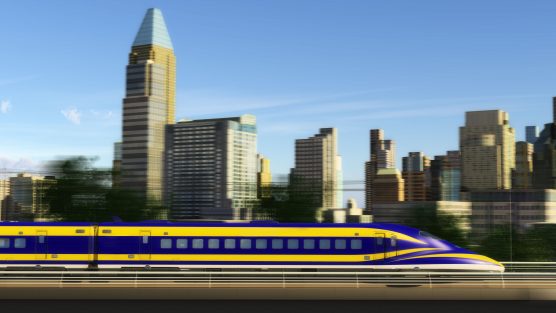SACRAMENTO – The California High-Speed Rail Authority and the Los Angeles County Metropolitan Transportation Authority announced today the approval of a joint funding agreement that allocates $76.7 million in Proposition 1A bond funds toward the Rosecrans Avenue/Marquardt Avenue Grade Separation Project in the city of Santa Fe Springs.
This contribution will be matched by other local funding sources to complete the $155.3 million project.
The project will separate vehicle traffic from the rail traffic by constructing an elevated overpass structure which will greatly improve safety, eliminate delays and improve air quality.
The crossing, traversed by about 110 freight and passenger trains and more than 52,000 vehicles per 24-hour period, has been rated by the California Public Utilities Commission as one of the most hazardous grade crossings in California.
Construction is anticipated to start as early as 2021 and the project is targeted for completion in 2023.
The rail corridor through this grade crossing has major freight operations by BNSF Railway, as well as commuter and intercity rail services by Amtrak and Metro. These tracks are part of the Los Angeles–San Diego–San Luis Obispo Rail Corridor, the second busiest intercity passenger rail corridor in the country.

“Funding for this priority investment within the Burbank to Anaheim corridor will improve freight, local and regional passenger rail service, enhance transit connections, improve safety, and accommodate the introduction of high-speed rail service in Southern California,” said Authority CEO Brian Kelly.
Proposition 1A, the High-Speed Rail Act approved by voters in 2008, included $1.1 billion in funding for the construction of locally sponsored “bookend” projects. Of this amount, $500 million was designated toward a broad list of projects in Southern California through a Southern California Memorandum of Understanding.
In early 2017, the Rosecrans Avenue/Marquardt Avenue Grade Separation Project was identified as the first project to be funded. In mid-2017, the Authority’s Board of Directors approved the project’s funding plan, authorizing execution of the agreement. Remaining project costs will be matched by a variety of federal, state, local and private sources.
“This grade separation project will go a long way toward improving safety and enhancing passenger rail and freight services within our county,” said Metro CEO Phillip A. Washington. “With hundreds of trains and traffic traveling through this critical intersection, these improvements will be a win-win for all Angelenos.”
This project will provide significant near-term mobility, safety, environmental and economic benefits to the region by making necessary improvements for high-speed rail service. Project benefits also include increasing passenger rail capacity to the Inland Empire by 60 percent.

California High Speed Rail Authority
The California High-Speed Rail Authority is responsible for planning, designing, building and operation of the first high-speed rail system in the nation. California high-speed rail will connect the mega-regions of the state, contribute to economic development and a cleaner environment, create jobs and preserve agricultural and protected lands. By 2029, the system will run from San Francisco to the Los Angeles basin in under three hours at speeds capable of over 200 miles per hour. The system will eventually extend to Sacramento and San Diego, totaling 800 miles with up to 24 stations. In addition, the Authority is working with regional partners to implement a statewide rail modernization plan that will invest billions of dollars in local and regional rail lines to meet the state’s 21st-century transportation needs.
About Metro
The Los Angeles County Metropolitan Transportation Authority is unique among the nation’s transportation agencies. Created in 1993, Metro is a multimodal transportation agency that transports about 1.3 million passengers daily on a fleet of 2,200 clean air buses and six rail lines. The agency also oversees bus, rail, highway and other mobility-related building projects and leads transportation planning and programming for Los Angeles County.
Like this:
Like Loading...
Related





 Tweet This
Tweet This Facebook
Facebook Digg This
Digg This Bookmark
Bookmark Stumble
Stumble RSS
RSS




























REAL NAMES ONLY: All posters must use their real individual or business name. This applies equally to Twitter account holders who use a nickname.
1 Comment
Suck out Jerry Brown